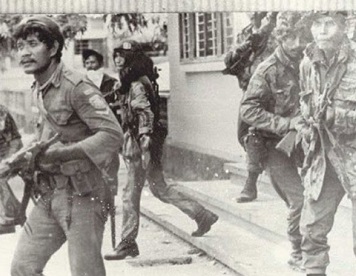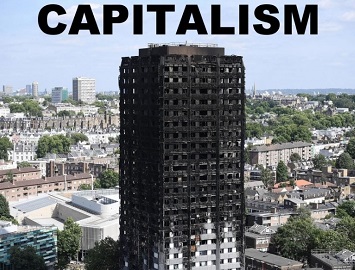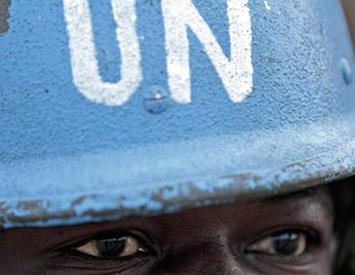Historian Dr Adam Hughes Henry says Western media – and notably our own ABC – are presenting a self-serving and grossly distorted account of the 1989 'Tiananmen Square massacre'.
READING THE ABC ONLINE NEWSWIRE, I am provided with a significant amount of information outlining the ‘Tiananmen Square massacre’, much righteous indignation from western observers and pundits, and calls for the Chinese Communist Government to come clean about these events, including by luminaries such as Hamish MacDonald.
Yet this is a confusing situation.
On the one hand, a tyrannical Communist Government is certainly not a far-fetched narrative bereft of numerous facts that could outline such a story with little difficulty. Neither is the tragic story of human rights in China — there are numerous examples of the kinds of injustices that occur and continue to occur and they are well documented.
On the other hand, it occurs to me that amongst all of this condemnation over the ‘Tiananmen Square massacre’, is this not the same government which nations like Australia and the rest now consistently praise for those sweeping economic reforms; whose economic growth is held to be some kind of validation of the neo-liberal fundamentalism that has engulfed the globe? There is no mention of the irony of this in any of the ABC coverage I have examined.
Are they suddenly a different type of government, a nicer, friendlier type of authoritarian regime?
Why then do we trade so extensively with such a nation, why do our mining companies grow fat from Chinese purchases, what exactly did the great economic reforms allow China to provide to the world economy that makes neo-liberal advocates swoon?
I should like to come back to this, but first I’d like to outline some well documented points about Tiananmen and the Western reporting of this event.
Throughout the ABC coverage online, there was not one specific mention of crucial pieces of information that effectively deconstruct the standard western analysis of the ‘Tiananmen Square massacre’. These pieces of information are all easily found in this digital age and it is difficult to fathom exactly how the ABC might have omitted any – and indeed all – references to them.
The simple story of a pro-democracy protest by university students in Tiananmen Square and their subsequent massacre by members of the Chinese armed forces fits neatly into Western perceptions of what occurred and highlight the selectivity of the Western human rights condemnation. Consistent throughout the ABC coverage is the moral high ground occupied by the West, as per the standard requirements of mainstream journalism — an unquestioned truism.
According to a former U.S. correspondent who covered the protests, Jay Matthews, and a number of other sources, the Western reporting of what happened in Tiananmen Square was littered with misinformation and numerous inaccuracies.
The falsehoods that became part of the preferred Western narrative of the event quickly becoming embedded in news reports throughout the Western world. Matthews highlights, that despite numerous inferences otherwise then and now, no students – as far as we know – were actually killed in Tiananmen Square and that those that had stayed to the end were allowed to leave the square by security forces.
Just to make this clear: there was no wholesale massacre of protesting students in Tiananmen Square.
Why then does it feel that, by coming to this reasoned conclusion using solid evidence easily accessible to those who care to look, one enters into a world of atrocity denial?
I would suggest this is because it runs counter to the preferred Western narrative of ‘The Tiananmen Square massacre’ and its righteous indignation and selective empathy with the thwarted attempt to be ‘free’.
Students did die that night and this is, of course, awful — but so did far greater numbers of non-students, in and around the connecting suburbs and streets not far from Tiananmen.
There was a massacre, but not the one the Western media propagated through its careless reporting and continues to peddle.
As Black and Munro noted in 1993:
The phrase "Tiananmen Square massacre" is now fixed firmly in the political vocabulary of the late twentieth century. Yet it is inaccurate. There was no massacre in Tiananmen Square on the night of June 3. But on the western approach roads, along Chang'an Boulevard and Fuxingmen Avenue, there was a bloodbath that claimed hundreds of lives when the People's Liberation Army found its path blocked by a popular uprising that was being fuelled by despair and rage. To insist on this distinction is not splitting hairs. What took place was the slaughter not of students but of ordinary workers and residents - precisely the target that the Chinese government had intended.
In reading the ABC coverage, the focus on the students perpetuates the idea that they and only they were the targets of the crackdown.
In fact, the workers of the surrounding suburbs were also protesting that night and supported the student protests, and were the true target:
The official conspiracy theory demanded other threats and other scapegoats - "outside elements" with "ulterior motives." This meant dissident intellectuals and workers. After their ruthless repression under Mao, the intelligentsia had been granted a kind of historic compromise by Deng. But by the spring of 1989, they had come to be seen as the agents of bourgeois liberalization, of China's "peaceful evolution" toward Western-style pluralism. After Tiananmen, they would be singled out for punishment. The working class, meanwhile, had become the carrier of an even more dangerous virus - the Polish disease…The students initiated the Tiananmen movement, and they brilliantly out maneuvered and embarrassed a leaden-footed government. But after the mass demonstrations of mid-May, the threat from the students was dwarfed by the intervention of much broader social forces.
Again, this is not difficult to verify, nor is the information obscure. They were angry at the economic reforms — the same reforms that have since turned Chinese workers into sweatshop fodder for Western corporations to much Western applause and rampant government corruption.
The treatment of the workers – and any protesters who found themselves in the streets around Tiananmen – was a violent and furious struggle against the security forces. Again easily documentable and easy to verify.
Totally ignored by the ABC is that the main target of the crackdown was not actually the students – who would certainly feel unjust political persecution following Tiananmen – but the workers in the surrounding areas, where the violent clashes actually took place in the streets and many people were killed by the security forces, were the carriers of the ‘Polish disease’.
Where is their story on the ABC, why are we not told why they were protesting, what were they protesting against, what happened to them?
No doubt, the Australian Embassy and many foreign correspondents saw terrible things that night in the streets and suburbs, but surely not a massacre of unarmed students gathered peacefully in Tiananmen Square. What they actually saw is provided in fragments, fragments that do not tell any reader the real context of the crackdown.
Why is it that the far greater and more significant workers protests and workers resistance is not the main focus of the story, or at least given some serious copy? Why is it that they have simply been written out of the ABC coverage and, in fact, appear to be irrelevant to their coverage.
If a wholesale massacre of students in Tiananmen Square remains a primary component of the 1989 story – and indeed this was the story seemingly told by the Western media almost immediately – and the university students (as the peaceful face of a pro-democracy movement) ruthlessly crushed are the worthy victims, what of the workers?
Could it be that the student protests appealed far more to the foreign correspondents and the West?
This could all be neatly understood in much the same simple way as what was happening in Eastern Europe; they were not really expressing historical and cultural dissent from decades of tyranny and corruption, or asserting their human rights as citizens, freedom of expression as unique human beings, or as workers tired of being exploited by governments — what they were really asking for, as far as we were concerned, was Western style democracy; or, in other words, to be just like us.
This would no doubt be natural conclusions by the Western media because, after all — who wouldn’t want to be just like us?
Yes, it is true that the Chinese Government is an authoritarian and corrupt regime, however – as demonstrated by the relationship with numerous other corrupt and authoritarian regimes – foreign multinationals and governments from the enlightened and freedom loving west apparently think nothing of creating military and or financial partnerships that not only prop up these regimes and protect them, but guarantee strategic gains and massive exploitative profits for shareholders while perpetuating human misery. The continued cost is to block, as a matter of daily diplomatic and economic practice, the very freedoms and human rights crushed so ruthlessly by the Chinese Government in 1989, which of course we condemn.
They will censor and attempt to whitewash the history of 1989 in order to preserve their order and control, but then so have we. They have been assisted in their propaganda efforts by the Western media whose inaccuracies, then and now, maintain the focus on a ‘Tiananmen Square Massacre’ of unarmed students by security forces.
The main story, missed or ignored by the Western media appears to be the suppression and destruction of the workers in and around Tiananmen Square. Through its inaccurate and selective condemnation, the Western media have effectively helped the Chinese Government to bury the story of 1989.
As a detailed 1989 study of U.S. media coverage highlights:
…this study nonetheless concludes that some of the media should have come closer to a rounded appreciation of the events of June 3-4 within the first week. Wildly inflated casualty figures and the use of the geographically erroneous catch phrase "Tiananmen Square massacre" gave the Chinese government a pretext for deflecting the central moral issue raised by its brutal response to the protesters. If some of the media were wrong about how many people died, and where, were they also wrong about the significance of the killings? No, they were not. But the exaggerations and the error of geography permitted that question to be raised, and undercut the media's credibility in some quarters.
Surely, even a most cursory moment of philosophical reflection would provide a some obvious conclusions for the ABC – the successful crackdown in 1989 made certain that
- the Chinese communist party would continue its rule without challenge; and
- that the so called economic reforms, routinely applauded by the West, would continue to be implemented on Chinese workers, no matter what the human cost.
There is no need for Western media condemnation of the human cost of the economic reforms buttressed by the crackdown. The result was a cheap Chinese workforce with few rights – let alone strong human rights – paid a pittance, who work under oppressive conditions for numerous Western multinationals under the watchful eye of the Chinese Communist Party — the same people we hypocritically condemn for the 1989 crackdown.
Not one Australian journalist and, particularly, the ABC appear at all interested in the very stark contrast between the tear stained reaction of the Australian Labor Party to events in China in 1989 and events much closer to home.
I can personally vouch for this.
I pitched a very reasonable and detailed program idea ‘The Tale of Two Massacres’ to the ABCs Hindsight program on Radio National; their response was, without explanation, to cease responding to my very genuine emails.
Is this comparison between the Australian Government reaction to Tiananmen and East Timor so outrageous, so beyond the pale, that the response from a top ABC current affairs radio program should be the coldest of shoulders?
Apparently so.
In 1989, Australia signed the Timor-Gap Treaty with Indonesia — a treaty that, in the clearest breach of international law, recognised the acquisition of territory by blatant and illegal armed aggression. It also ignored the maintenance of illegal Indonesian control by the most horrendous and ruthless of methods.
In 1991, the Labor Government did not publicly cry over dead East Timorese of the Dili Massacre; in fact, they downplayed the event and continued the Australian love affair with Suharto’s New Order Regime — aka one of the most corrupt, anti-human rights and murderous regimes of the 20th Century.
The student protesters of the ‘Tiananmen Square Massacre’ are worthy victims, the workers and residents irrelevant, while the Timorese and Indonesian victims of Suharto and his brutal military regime are to be conveniently forgotten.
Should we wait with bated breath for any comparable ABC expose on the Timor Gap or Dili Massacre as prominent and as outraged as we have seen recently on the ABC over Tiananmen?
The Western reporting of what was a most significant Chinese event in 1989 – the worker and student protests – has so distorted what actually happened, that it has promulgated the preferred Western narrative at the expense of the whole historical truth.
The current ABC coverage is little better; in fact, given the materials around to examine any or all of these points, a few of which are provided in this article, it is arguably worse.
I agree with Hamish MacDonald, it is never too late for the Chinese government to come clean over their repressive crackdown in 1989 and after — but I would also add, it is never too late for MacDonald, fellow journalists, and programs such as Hindsight to want get it right too.

This work is licensed under a Creative Commons Attribution-NonCommercial-NoDerivs 3.0 Australia License
Monthly Donation
Single Donation









